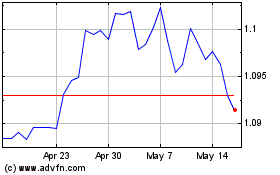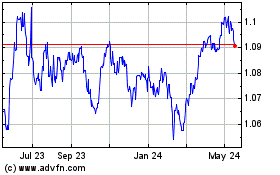NZ Dollar Rises After RBNZ's Expected 50 Bps Rate Cut
November 26 2024 - 8:45PM
RTTF2
The New Zealand dollar strengthened against other major
currencies in the Asian session on Wednesday, as the Reserve Bank
of New Zealand (RBNZ) announced its policy decision.
The Reserve Bank of New Zealand reduced its benchmark interest
rate by 50 basis points, as inflation moved close to the midpoint
of the target range and economic output remains below its
potential.
The Monetary Policy Committee governed by Adrian Orr decided to
reduce the Official Cash Rate to 4.25 percent from 4.75
percent.
Policymakers expect economic growth to recover next year, as
lower interest rates boost investment and other spending. However,
employment growth is forecast to remain weak until mid-2025.
The MPC cautioned that exact speed and timing of the recovery is
subject to uncertainty. Traders remain cautious ahead of the
release of a key U.S. inflation measure, the Thanksgiving holiday
in the U.S. and uncertainty over Trump's tariff plans. Markets were
positive after Israel approved a US-brokered ceasefire agreement
with Lebanon's Hezbollah.
Traders also react to the minutes of the US Fed's latest
monetary policy meeting that revealed officials believe it will be
appropriate to "gradually" lower interest rates. They also await a
slew of US economic data, including the Fed's preferred readings on
consumer price inflation for clues on the interest rate
outlook.
In economics news, data from the National Bureau of Statistics
showed that China's industrial profits declined at a slower pace in
October. Industrial profits posted an annual decline of 10 percent
on a yearly basis in October. This follows a sharp 27.1 percent
decrease in September.
The improvement in October was partly due to the low base of
comparison.
In the Asian trading now, the NZ dollar rose to a 9-day high of
1.1013 against the Australian dollar, a 6-day high of 0.5882
against the U.S. dollar and a 2-day high of 1.7834 against the
euro, from yesterday's closing quotes of 1.1092, 0.5834 and 1.7973,
respectively. If the kiwi extends its uptrend, it is likely to find
resistance around 1.09 against the aussie, 0.60 against the
greenback and 1.76 against the euro.
Against the yen, the kiwi edged up to 89.89 from an early more
than a 2-month low of 89.10. The kiwi may test resistance around
the 93.00 region.
Looking ahead, the market research group GfK releases Germany's
consumer confidence survey data for December at 4:30 am ET. The
forward-looking consumer sentiment index is expected to fall to
-18.8 in December from -18.3 in November.
In the New York session, U.S. weekly mortgage approvals data,
U.S. Core PCE price index for October, personal income and spending
for October, durable goods orders for October, pending home sales
for October, U.S. Chicago PMI for November, U.S. EIA crude oil data
and U.S. Baker Hughes oil rig count data are slated for
release.
AUD vs NZD (FX:AUDNZD)
Forex Chart
From Oct 2024 to Nov 2024

AUD vs NZD (FX:AUDNZD)
Forex Chart
From Nov 2023 to Nov 2024


